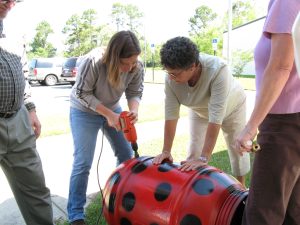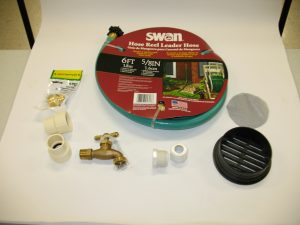
While it doesn’t feel like it lately, northwest Florida gets a LOT of rain. And when I say a lot, I mean the highest average rainfall in the Southeast (tying with Mobile, AL at over 65″), which rivals pretty much the rest of the country. We get more rain in some of our thunderstorms than states like Nevada and Arizona get in a full year. This is great news for our rivers, streams, and groundwater, which supply our drinking and irrigation water. But we often get more than we need, with flash floods inundating streets and sometimes homes. So what can we do with this excess?

There are plenty of engineering solutions like stormwater ponds, pipes, pumps, and reservoirs. But if homeowners want to capture a little of that extra rain to use for a sunny day, rain barrels are a great option. Harvesting rainwater is an ancient practice, with aqueducts and cisterns found all over the world and in old archaeological sites. Many of our forebears used it for drinking water before wells and filtration were developed.

Modern rain barrels involve ancient technology that relies simply on gravity, allowing stormwater to run from a rooftop into a gutter. The gutter funnels water into a plastic food-grade barrel or other container fitted with screen to keep out debris and insects.
Most rain barrels also have an overflow device near the top (for heavy storms that might fill the barrel) and a spigot at the bottom for filling a watering can or attaching a hose. Keep in mind the barrels do not have a lot of pressure and cannot irrigate an entire lawn, but are ideal for vegetable gardens and container plants. Rain barrels vary widely in design, but they can be painted to add a decorative touch, or easily screened behind a shrub. Larger containers, typically called cisterns, may hold hundreds of gallons of water, with the capacity and pressure to run more in-depth irrigation.

In addition to reusing rainwater, rain barrels can be an effective means of reducing stormwater pollution. During a typical 1” rainstorm, an average home’s roof can yield 600 gallons of rainwater runoff that would normally flow downstream, picking up oils, greases, bacteria, trash, and pesticides along the way that end up in our water bodies. These pollutants eventually flow downstream to our creeks, bayous, and bays, contributing to non-point source pollution. Rain barrels interrupt that process by collecting runoff before it has a chance to pick up pollutants.

There are lots of options available commercially for pre-built rain barrels, with a wide range of sizes, designs, and costs. They can also be a relatively simple DIY project. For many years, our office has held rain barrel building workshops. These consist of a short talk and a hands-on effort where participants prepay for equipment and leave with a fully assembled rain barrel. Hardware can be found at most home improvement stores, while a couple of local farm supply stores carry food-grade 55-gallon plastic barrels. The only specialized equipment needed is a 6” hole saw, which is used to drill a circular hold in the lid for a roof gutter downspout.
If you’re interested in more information about rain barrels or building your own, reach out to me at ctsteven@ufl.edu!
 8
8
